1lumen selects and reviews products personally. We may earn affiliate commissions through our links, which help support our testing.
Olight Arkflex review
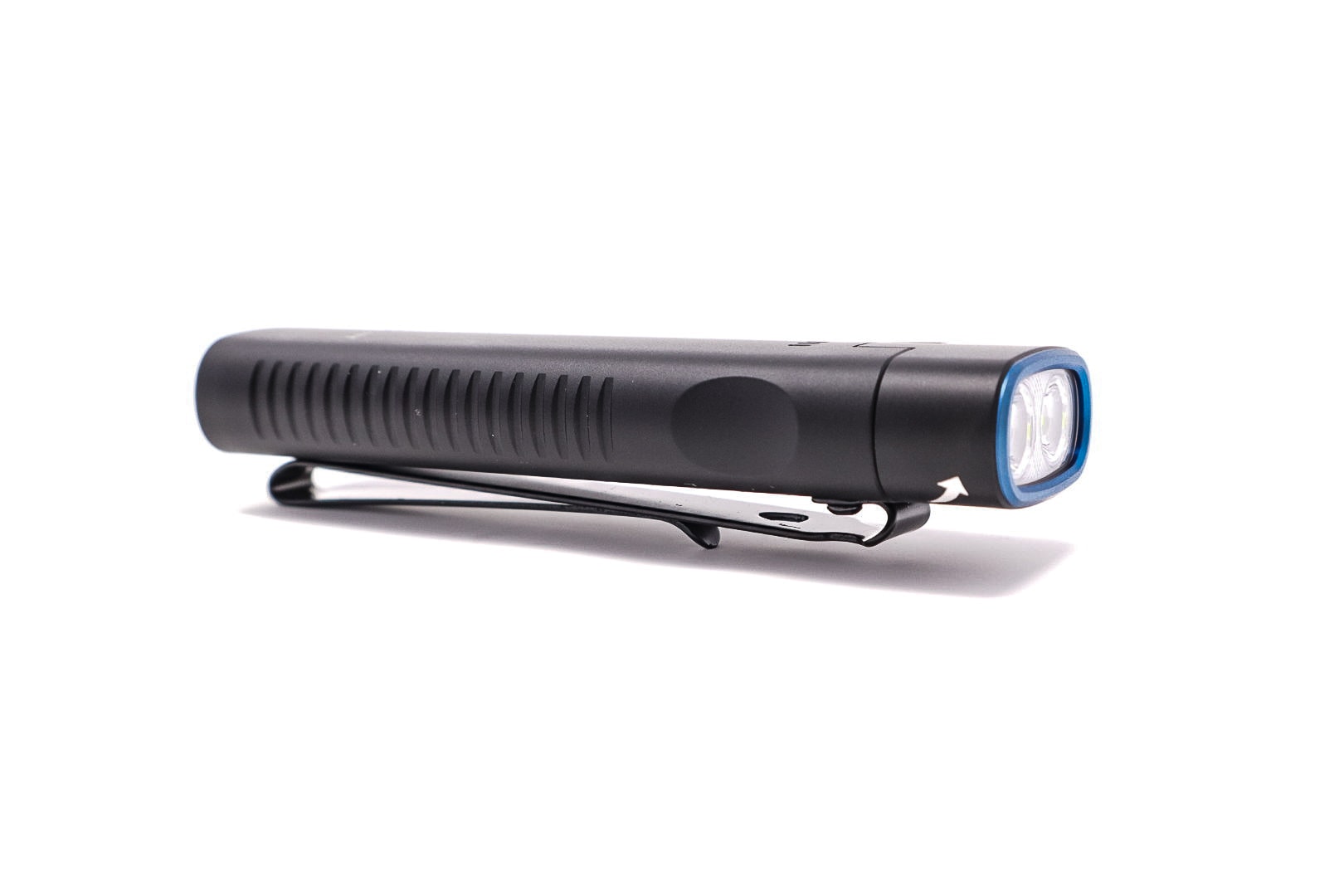
Olight Arkflex specs
| Brand & Model | Olight Arkflex |
|---|---|
| Flashlight category | EDC |
| LED | N/A (“High performance LED”) |
| Max. output | 1,000 lumens |
| Max. beam distance | 85 meters |
| Max. beam intensity | 1,900 cd |
| Battery config. | Built-in |
| Onboard charging | Olight MCC |
| Main modes | 5 |
| Blinkies | Strobe |
| Waterproof | IPX7 |
| Review publication date | December 2023 |
Review intro:
Olight has a pretty broad selection of lights. They make some great keychain lights such as the i3E EOS and the i1R 2 Pro. Olight also has EDC lights like the Baton series. But that’s not all… gun lights, tactical lights, high-power lights, general lamps/lanterns, and now branching out into things like knives and pens. For the most part, if it needs to be lit up, Olight has you covered. One of the things I love most about Olight is their attention to detail. Quality is generally fantastic, anodizing and machining are great… they just know how to make a solid product.
This particular model – the Olight Arkflex – appears to be a close cousin of the relatively new and popular line of Arkfeld models. The Arkfeld models are slim, flat flashlights with multiple output options (white with UV and/or green laser). The new Olight Arkflex switches that up a bit; there’s just white output on this model. But it has a new trick up its sleeve: the Arkflex is Olight’s first articulating head flashlight. The head can rotate between 0° and 90° to get the perfect illumination angle.
The Arkflex arrives in lockout mode, so press and hold the center button for around 1 second to unlock the flashlight.
Package quality.
Some Olights come in fantastic heavy-duty two-part nested containers with splashy images of the light inside and meticulously arranged contents. Other lights, like some of the more EDC models, come in nice, but not overdone, packaging that feel like less of a presentation case and more of an actual carton to be recycled. The Arkflex came in one of the latter packages. It’s nice, clean, and gets the point across without investing too much in the box. Sliding out the inner, formed plastic tray reveals:
- Olight Arkflex
- Magnetic charging cable
- Manual
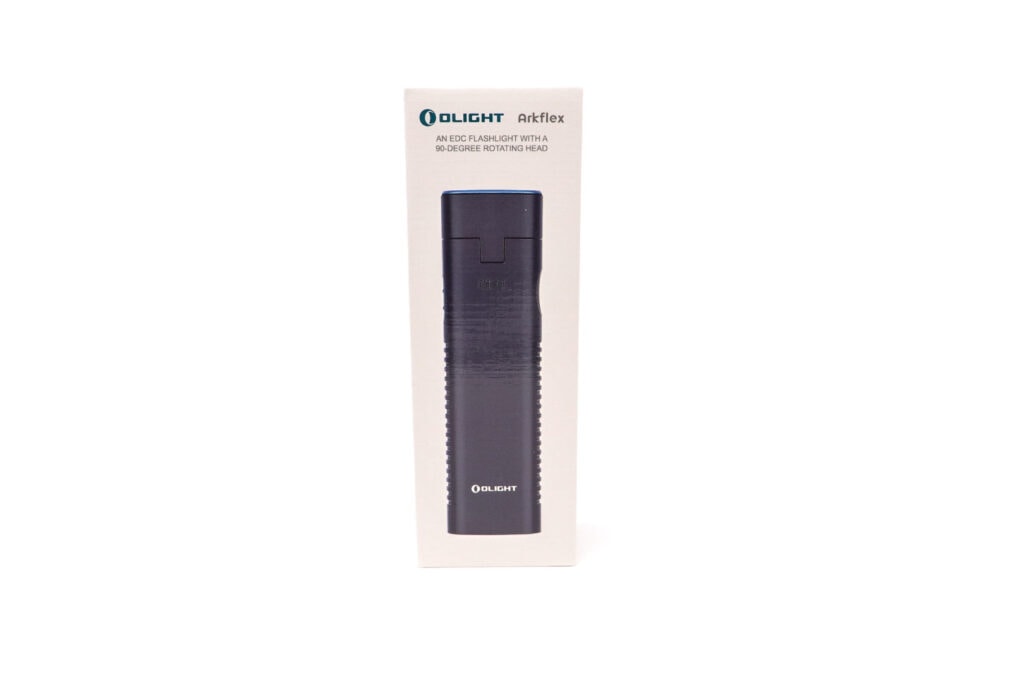
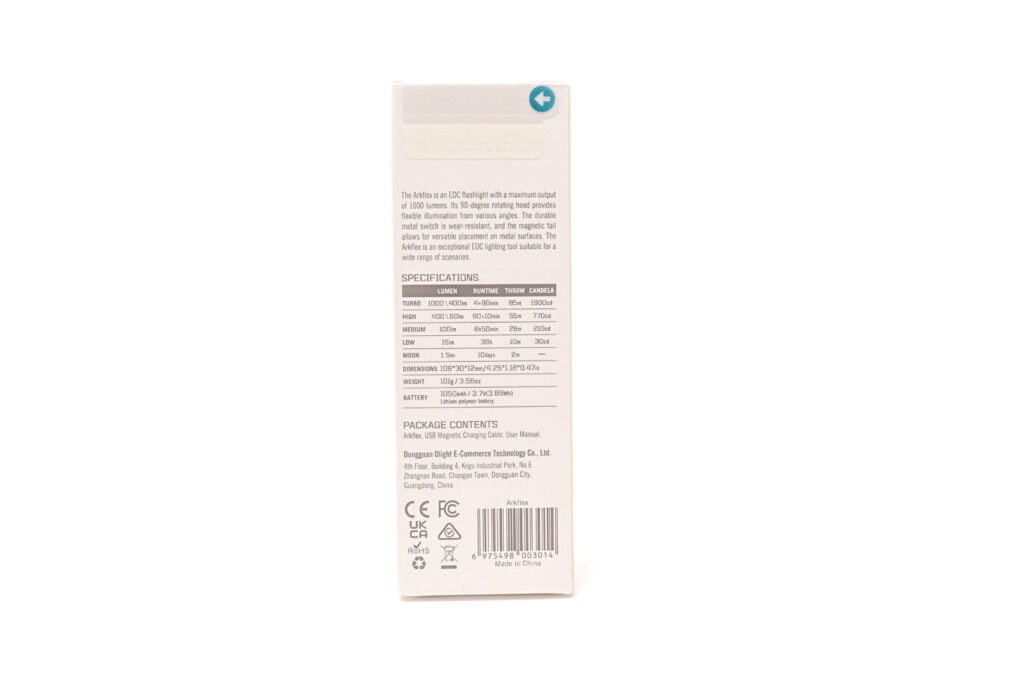
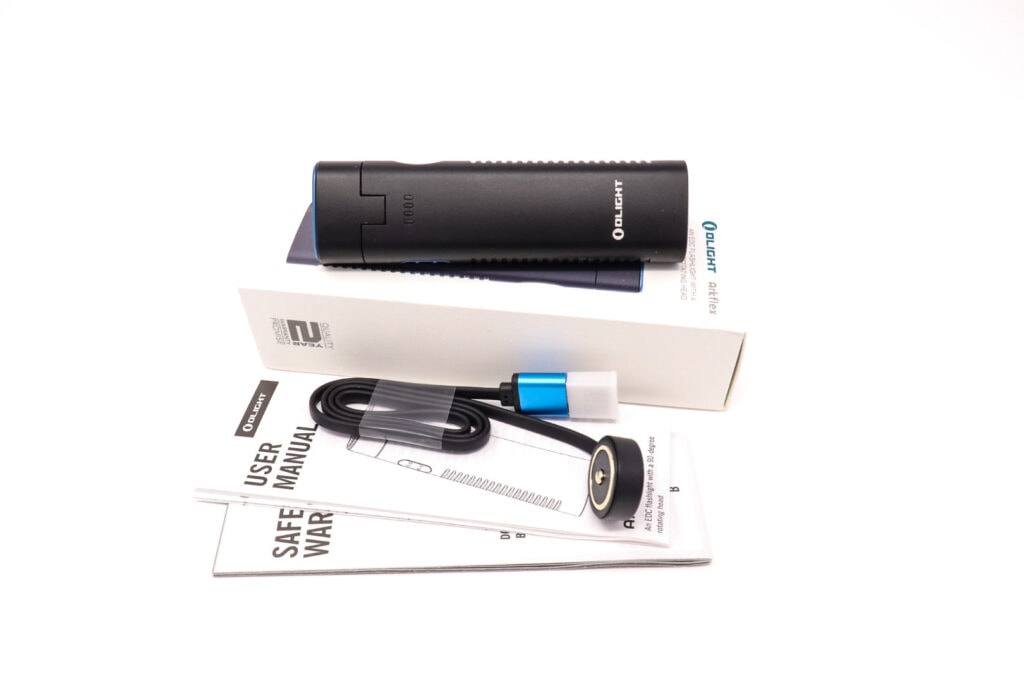
Flashlight in use, Build Quality, and Warranty
To me, there are two big, distinctive physical features of the Olight Arkflex. First, similar to its Arkfeld cousins, the Arkflex is flat…ish. The new Arkflex is mostly flat, but does take on a much more rounded appearance on the sides of the flashlight. The second main thing you’ll notice about this light is the headline feature: the head articulates, rotating up to 90°. Being able to position the head however you’d like, this lets you use the Arkflex as a traditional flashlight.
Or as the need arises, you can swivel the head and stick it in your pocket or clip it to your backpack strap for illumination as you go out to walk. Alternatively, make use of the magnetic tail and stick it to a work surface like a vehicle body and rotate the head to point to whatever you’re working on. You could even set it on a picnic table with the head tilted sideways to light up your grub, game, or reading material.
The roundedness isn’t the only departure in appearance from the Arkfeld line. To accommodate the articulating head, the switch has been relocated to the (narrower, left) side of the flashlight. The switch button is flush with the body and would be difficult to find in the dark, were it not for the 4 raised dots (similar to braille dots) on the button to provide tactile indication. The switch ring is gone, now that there aren’t multiple emitters to select from.
Another thing of note, the two-way pocket clip is much bigger now. It’s practically deep-carry whether you have it head-up or head-down. Not quite, but you get the gist. This isn’t merely a convenience factor, having the clip extend to the pivoting area helps with it’s stability when clipping it to a pocket or strap for forward-facing illumination.
The Arkflex feels really well built, as I would expect, and is constructed mostly of aluminum alloy with a nice anodized coating. Mine happens to be the black finish with blue accents, which is pretty sharp looking without being too wild. It looks like Olight is also offering the Arkflex in orange. Whenever a device has moving parts (hinges, clasps, etc), I always get a little voice in the back of my mind that questions the long-term dependability of them. The hinge on the Arkflex feels very stout and takes a good amount of pressure to move. Olight claims to have put it through over 10,000 swivel tests, so at least they’ve done their homework. It seems like it should be robust for the long haul, but only time will tell for sure.
Effective September 16th, 2023, Olight changed their warranty policy – and it’s a good one. Most lights used to carry a 2 year or 5 year warranty. Now, Olight covers their products purchased after January 1st, 2023 (in select countries) with a lifetime warranty. That guarantee even covers built-in batteries, which is great news for products like the Arkfeld and Arkflex which don’t have user-replaceable batteries.
From Olight’s website:
If you purchased an Olight® product from the USA after January 1st, 2023, the local service centers will honor your LIFETIME WARRANTY for your purchase. If your Olight product (including its structure, built-in battery, LED, or lens) ever experiences any issues, we promise to take care of it. If we are unable to repair your product, we will promptly replace it with a product in perfect working condition, which will be of equal or better physical condition. If your purchase is a limited or discontinued edition of Olight product, we will repair or replace it with another Olight product of the same or higher value.
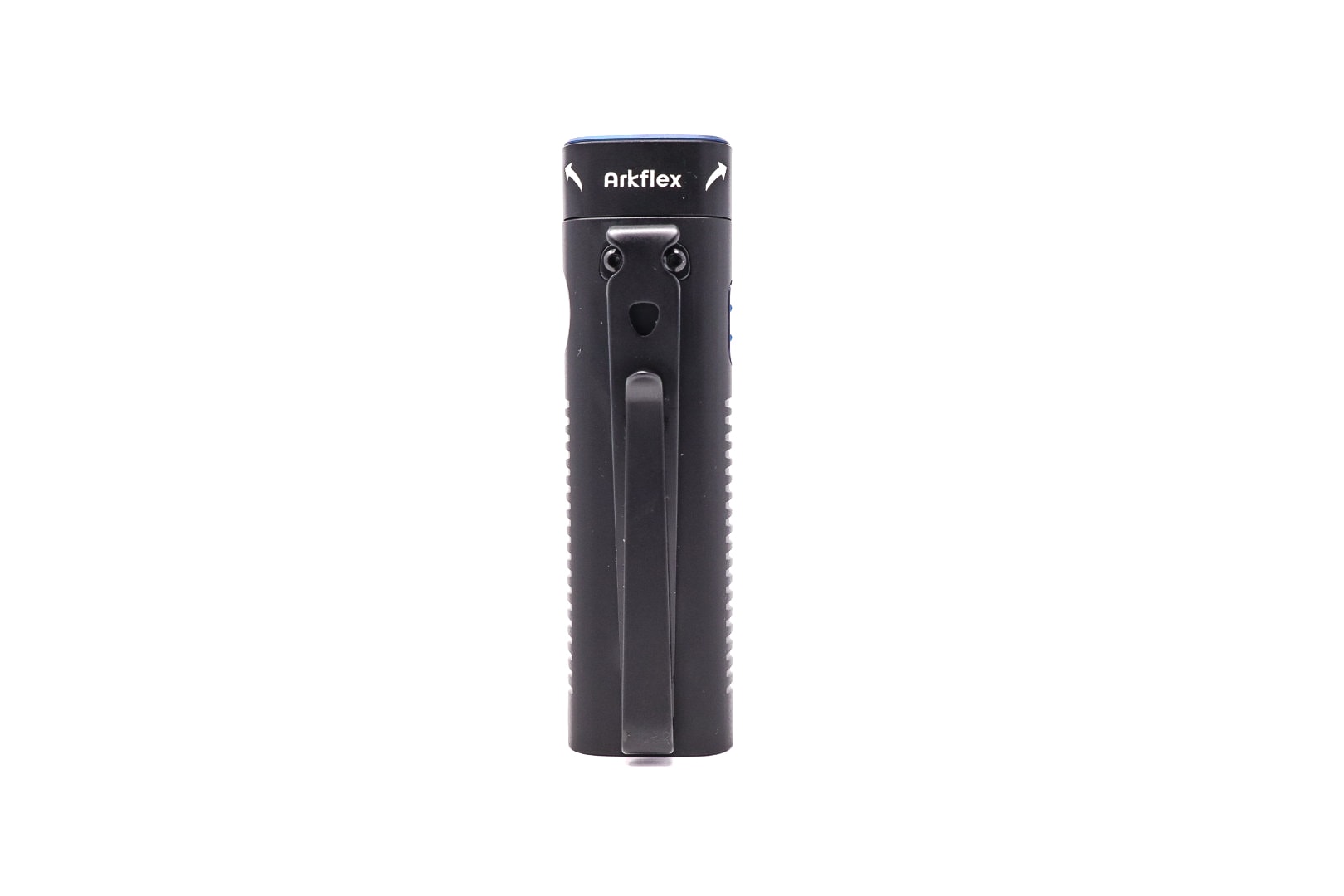

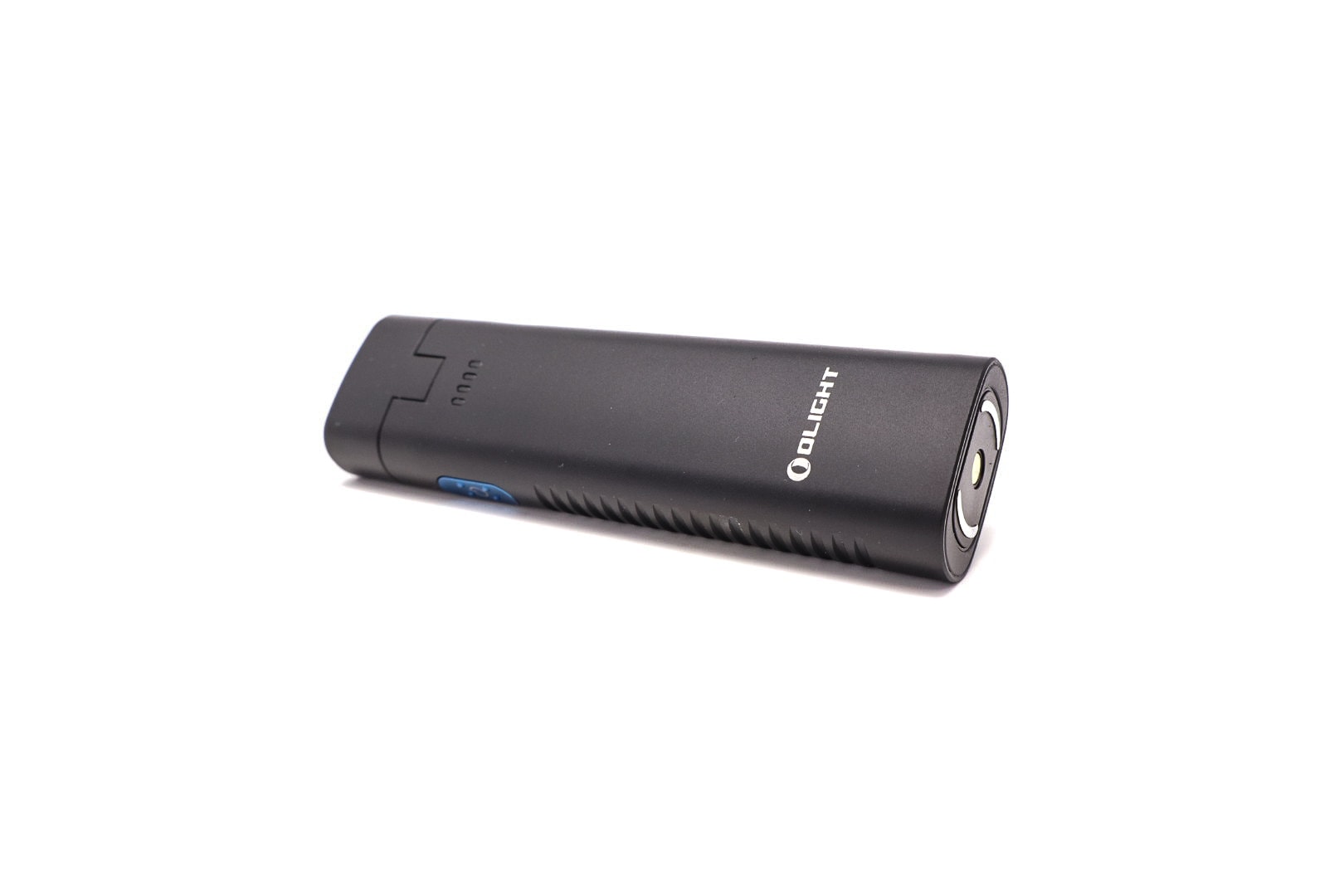
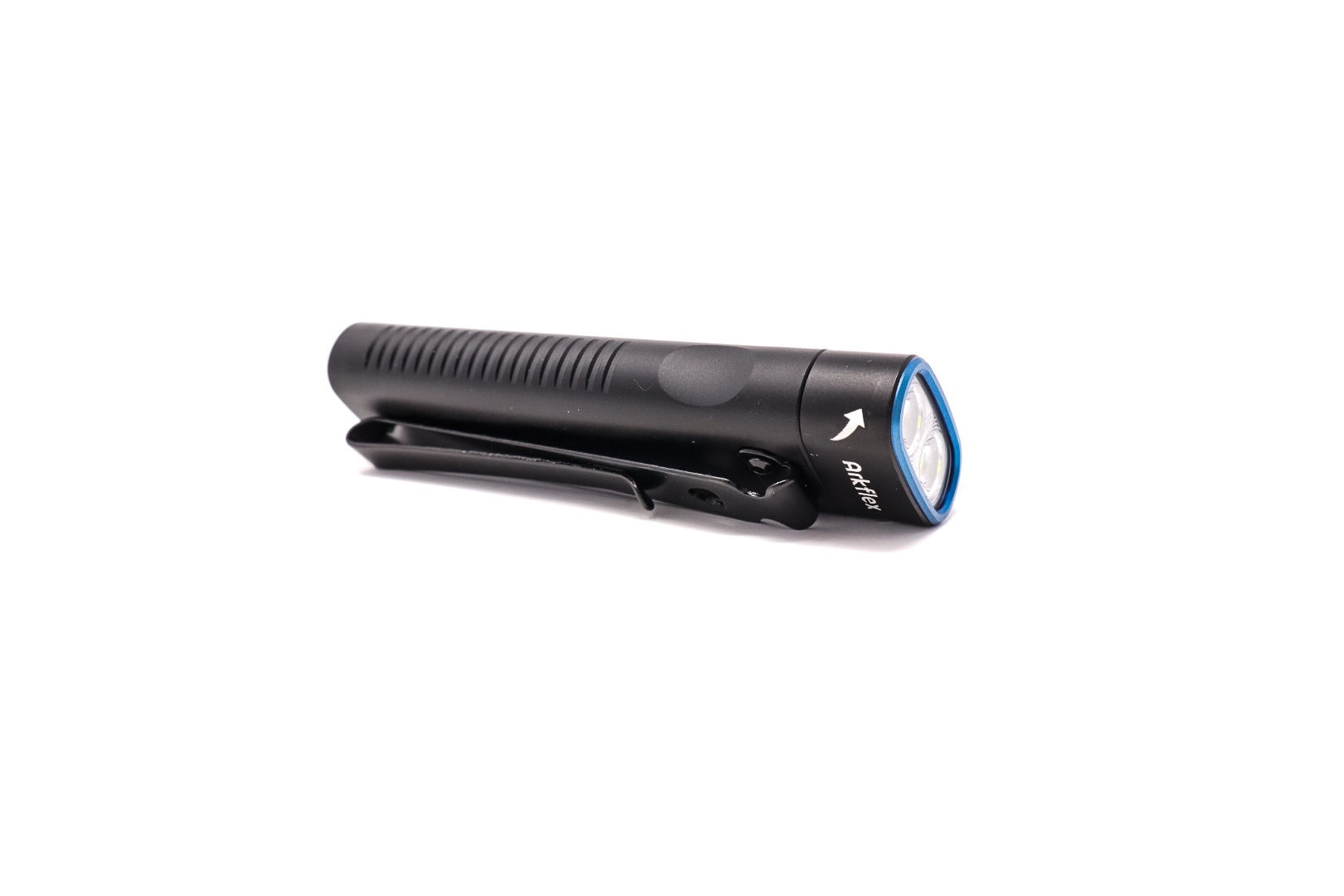
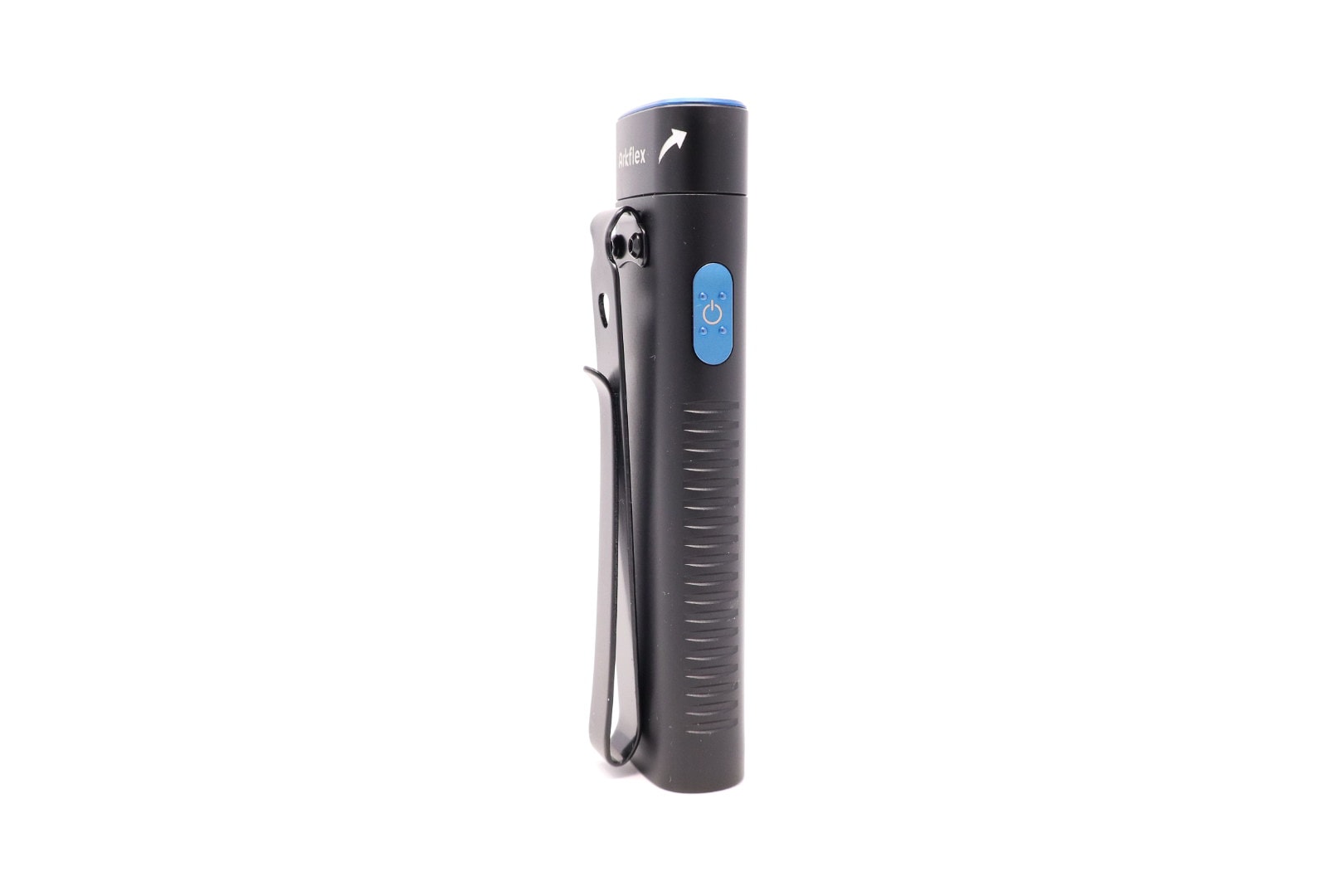
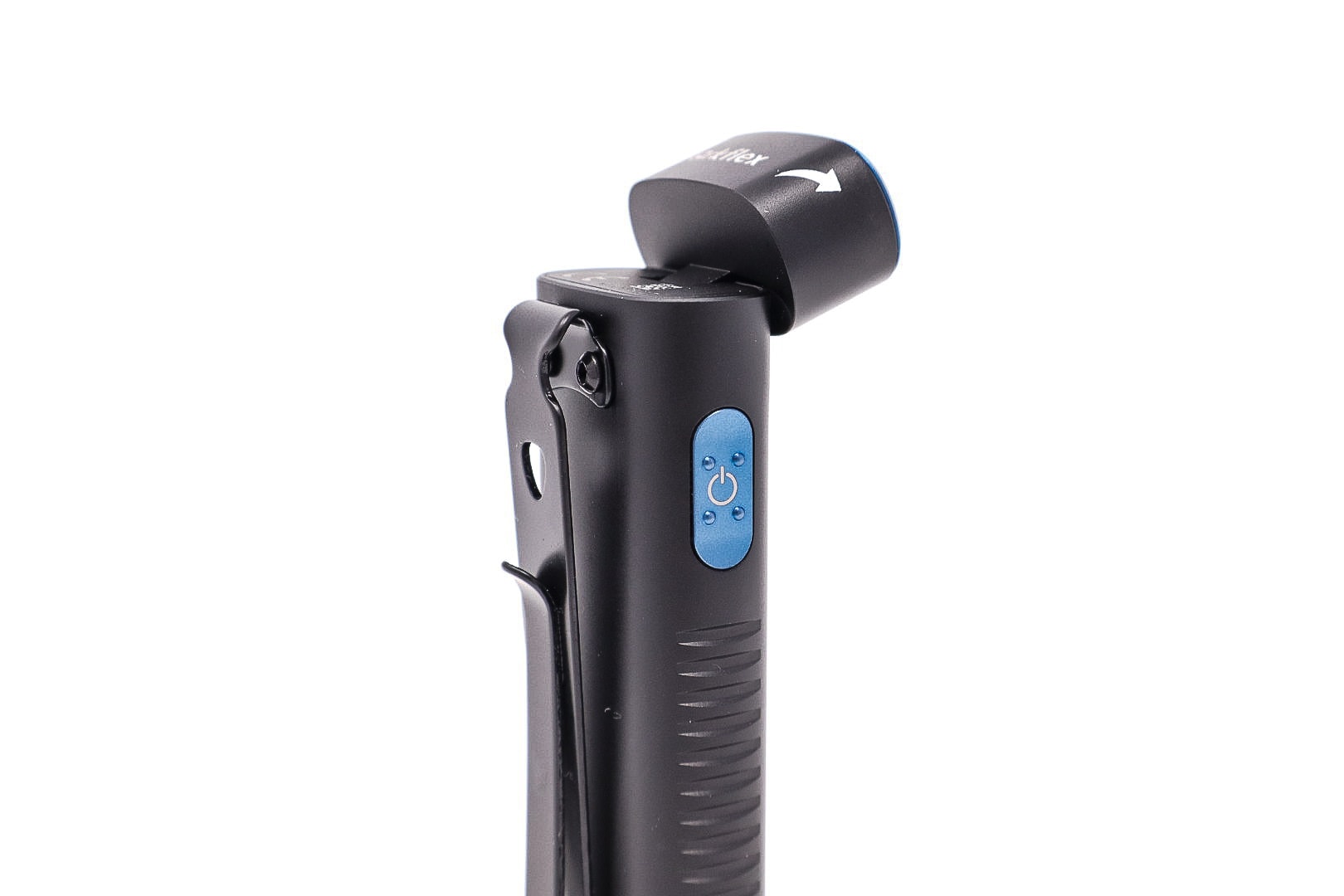
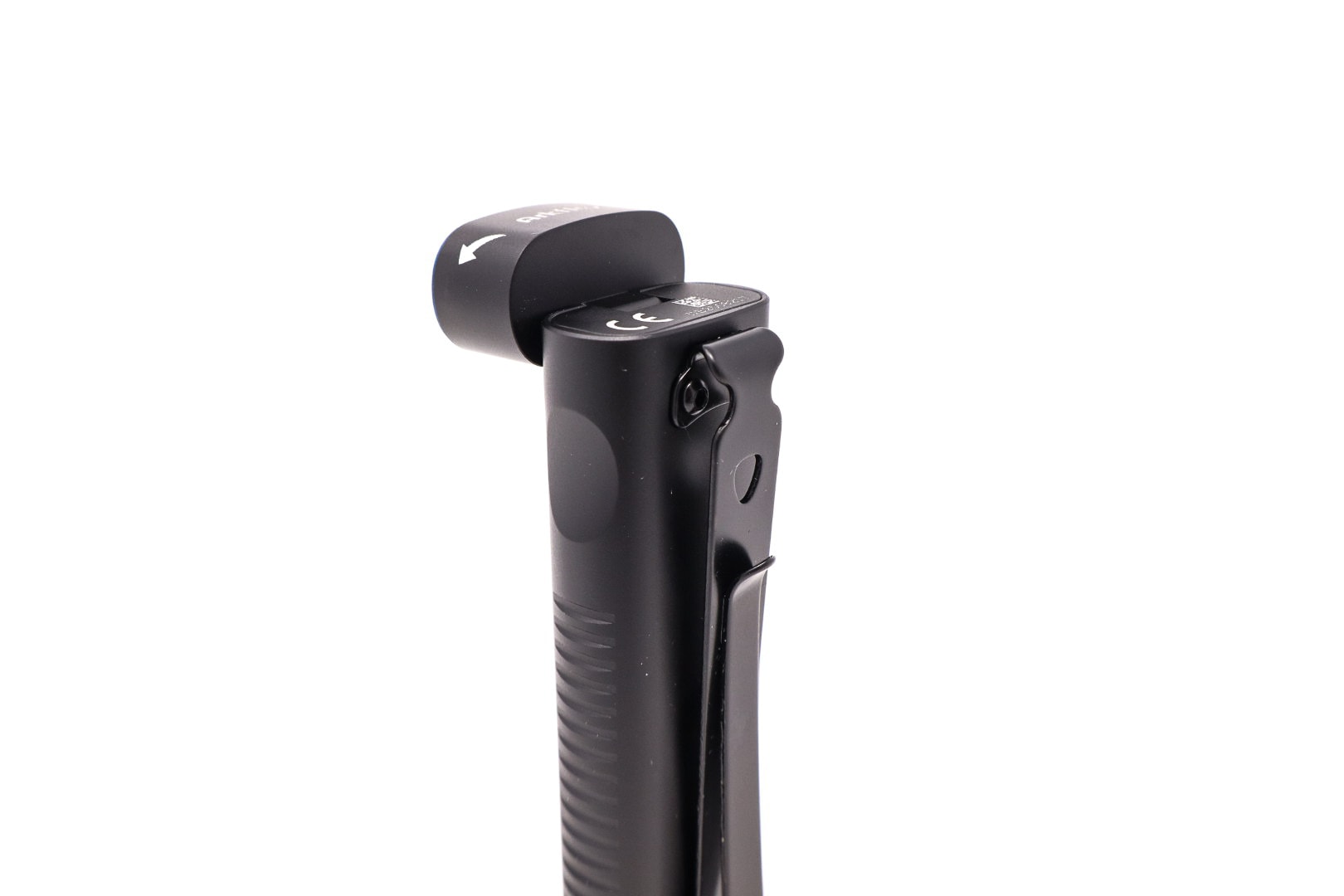
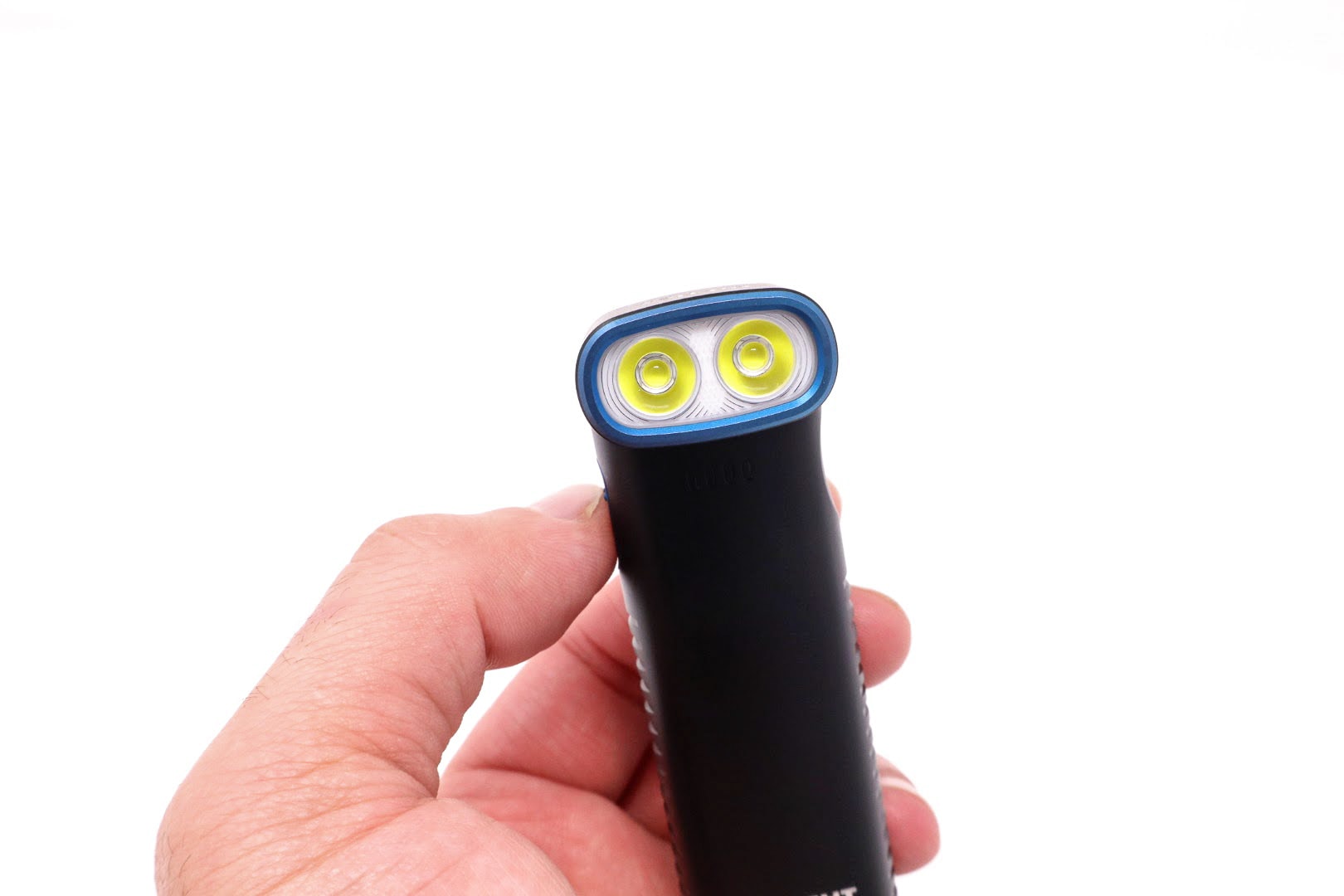

LED, Lens, Bezel, Beam, and Reflector
As is pretty common for Olight, there’s no mention of what LEDs lie beneath the optic, besides saying that they are “high performance cool white LEDs.” That’s not terribly helpful. Considering that Olight used OSRAM P9’s in the Arkfeld Pro, and the spectral measurements are extremely similar with this light, I wouldn’t be surprised if the Arkflex is also sporting OSRAM P9 LEDs. Unlike the Arkfeld models, there does not appear to be a Neutral White option at the time that I’m writing this.
The lens appears to be a custom two-well TIR setup, tailor made for the Arkflex. Unlike the Arkfeld models, this one has a cool little pattern formed into it (purely for aesthetics, non-functional). The lens creates a soft, even beam.
Spectral measurements:
I used an Opple Light Master to measure the flashlight at 5 meters distance.
| Mode: | CCT: | CRI Ra: | duv |
|---|---|---|---|
| Turbo | 6007 K | 68.7 | +0.0044 |
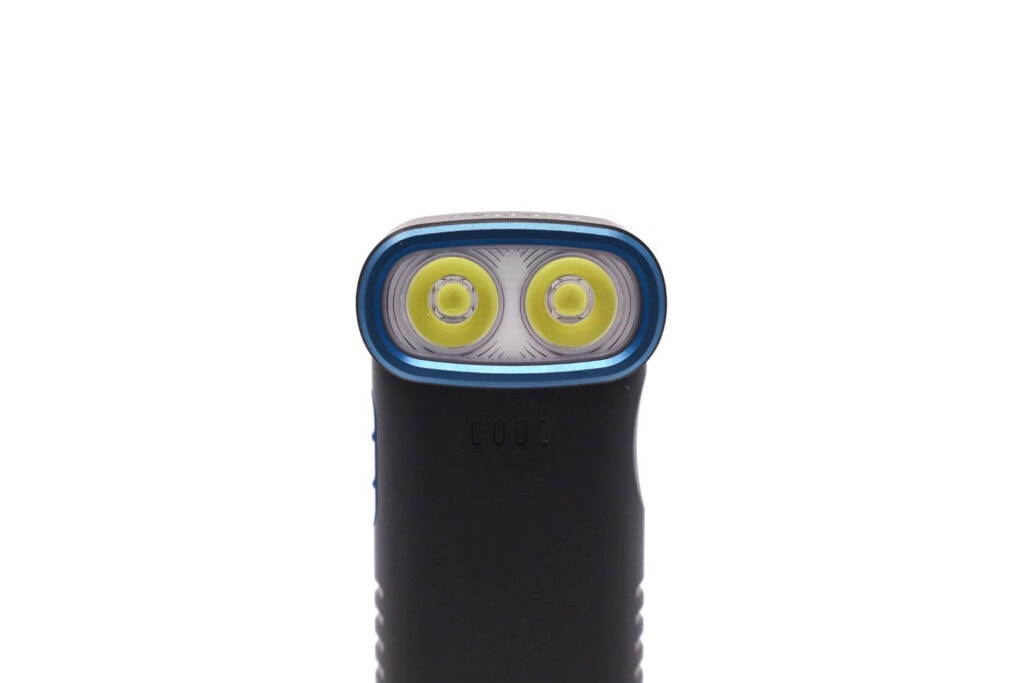
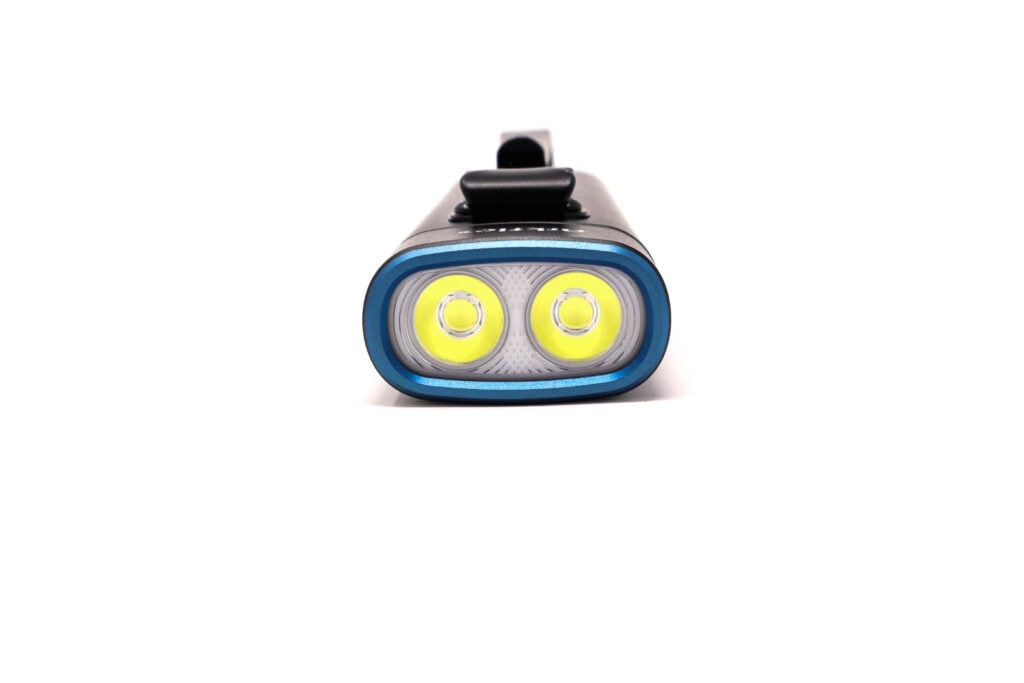
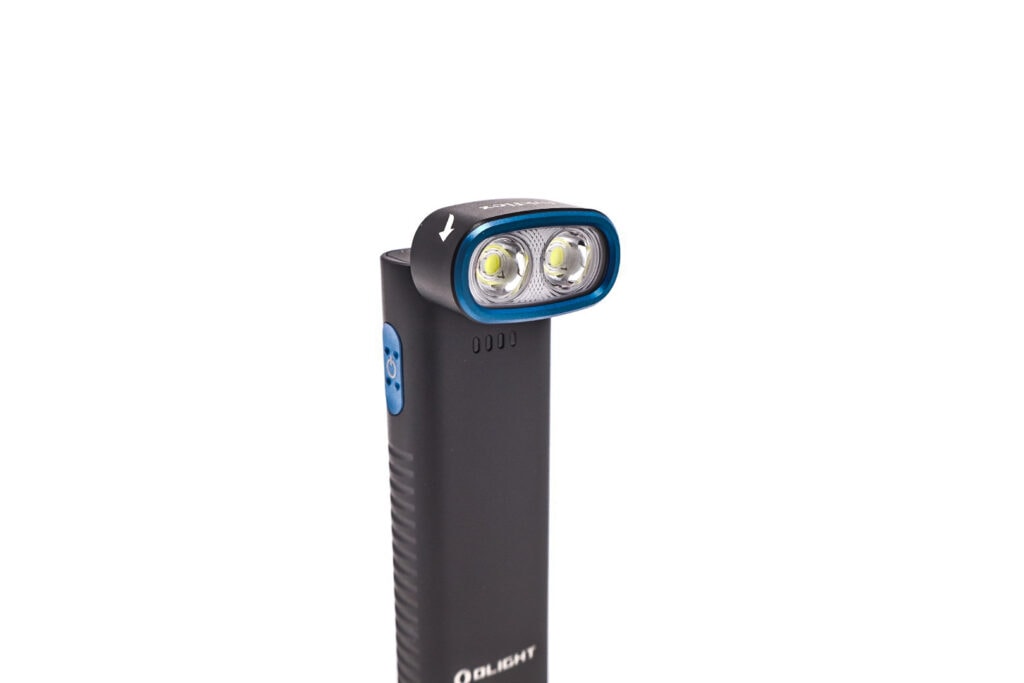

Dimensions and its competition
Dimensions:
| Olight Arkflex | Millimeters | Inches |
|---|---|---|
| Length | 108 mm | 4.3 in |
| Width | 30 mm | 1.2 in |
| Thickness | 17 mm | 0.7 in |
Dimensions are rounded to the nearest millimeter, and to the nearest tenth of an Inch.
Weight:
| Olight Arkflex | Weight in grams | Weight in oz |
|---|---|---|
| With battery | 101 g | 3.6 oz |
Weight is rounded to the nearest gram, and to the nearest tenth of an Oz.
Flashlight size comparison with its competition:
Group 1: Olight Arkflex, Olight Baton 3 Pro Max
Group 2: Olight Arkflex, Olight Arkfeld UV
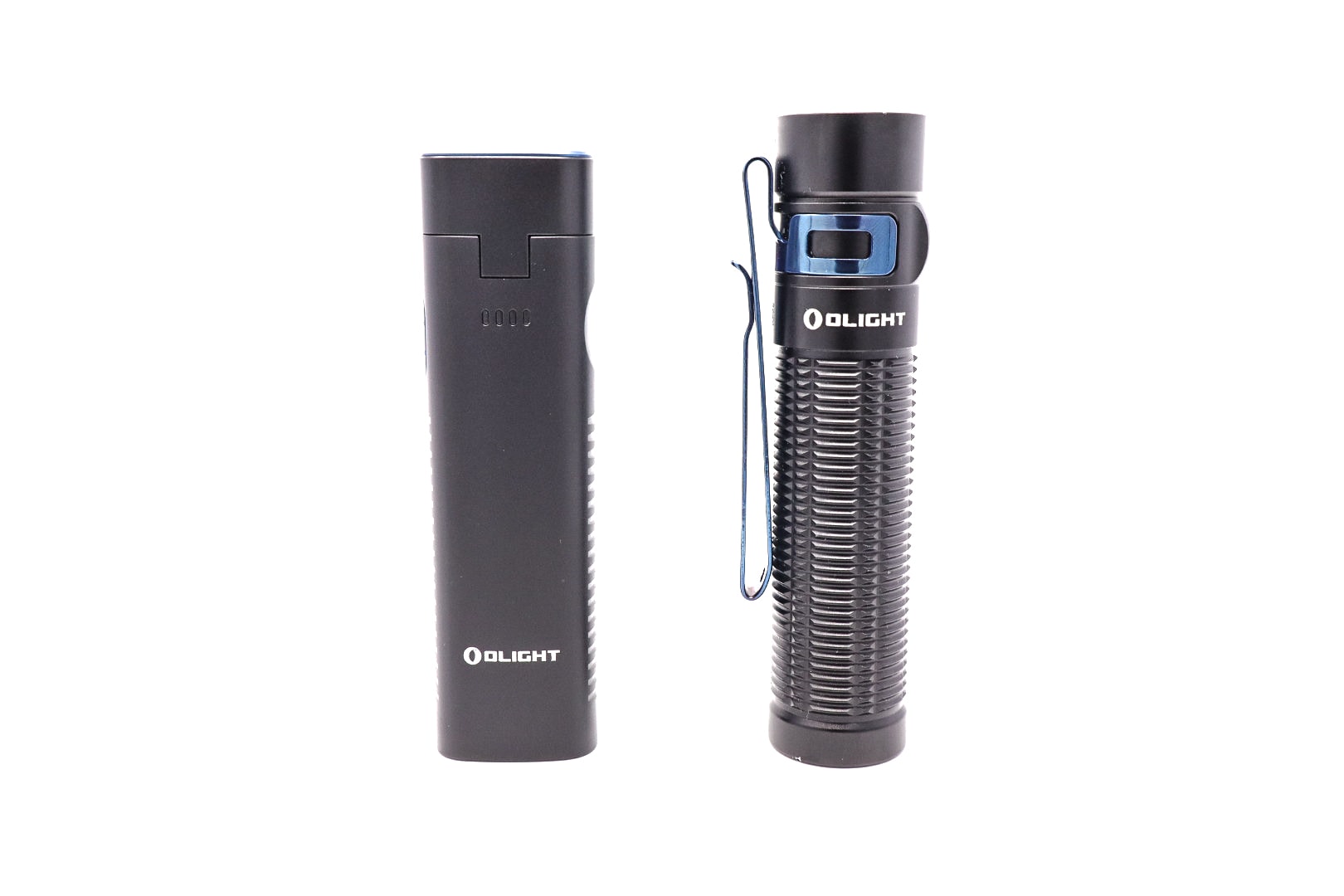
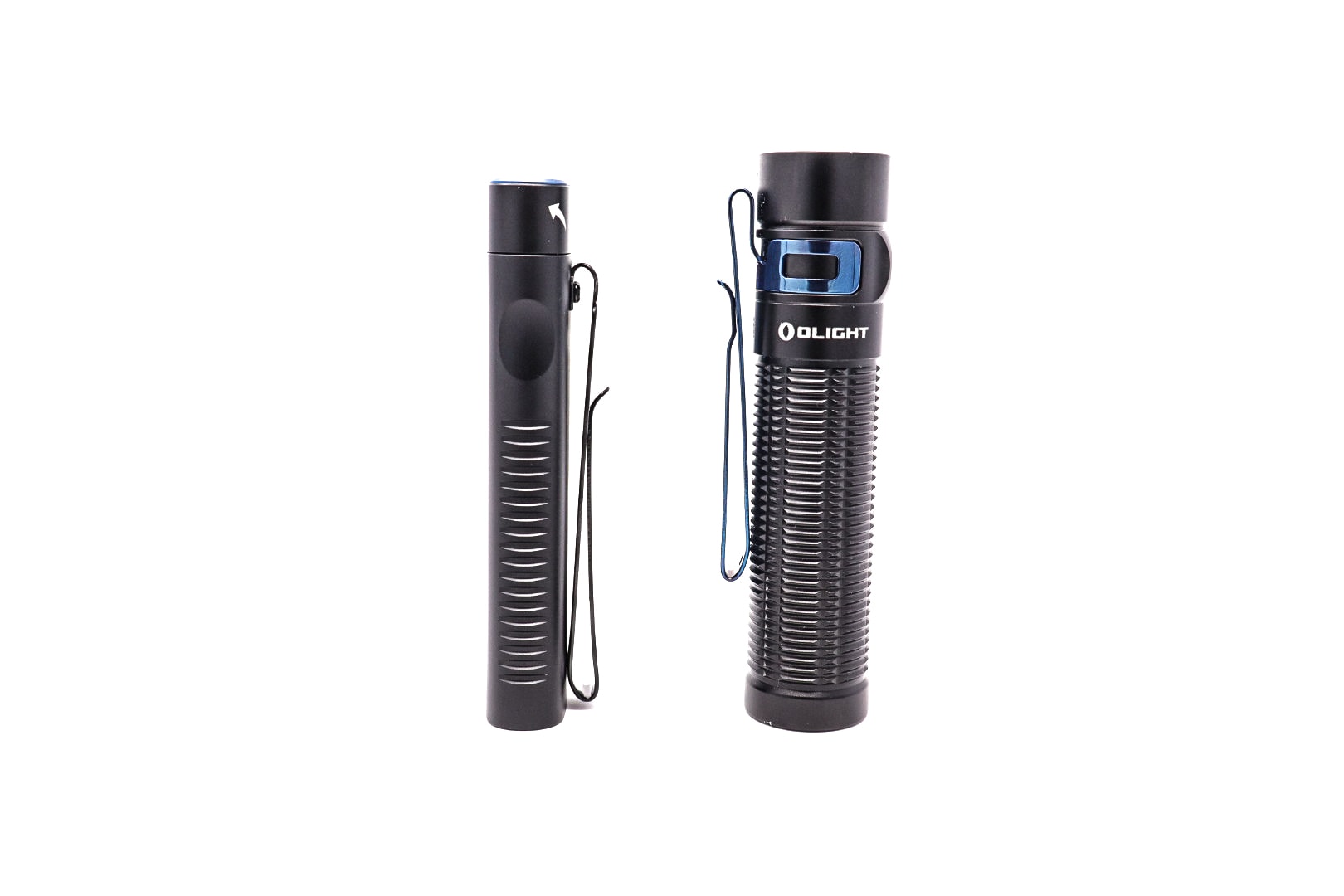
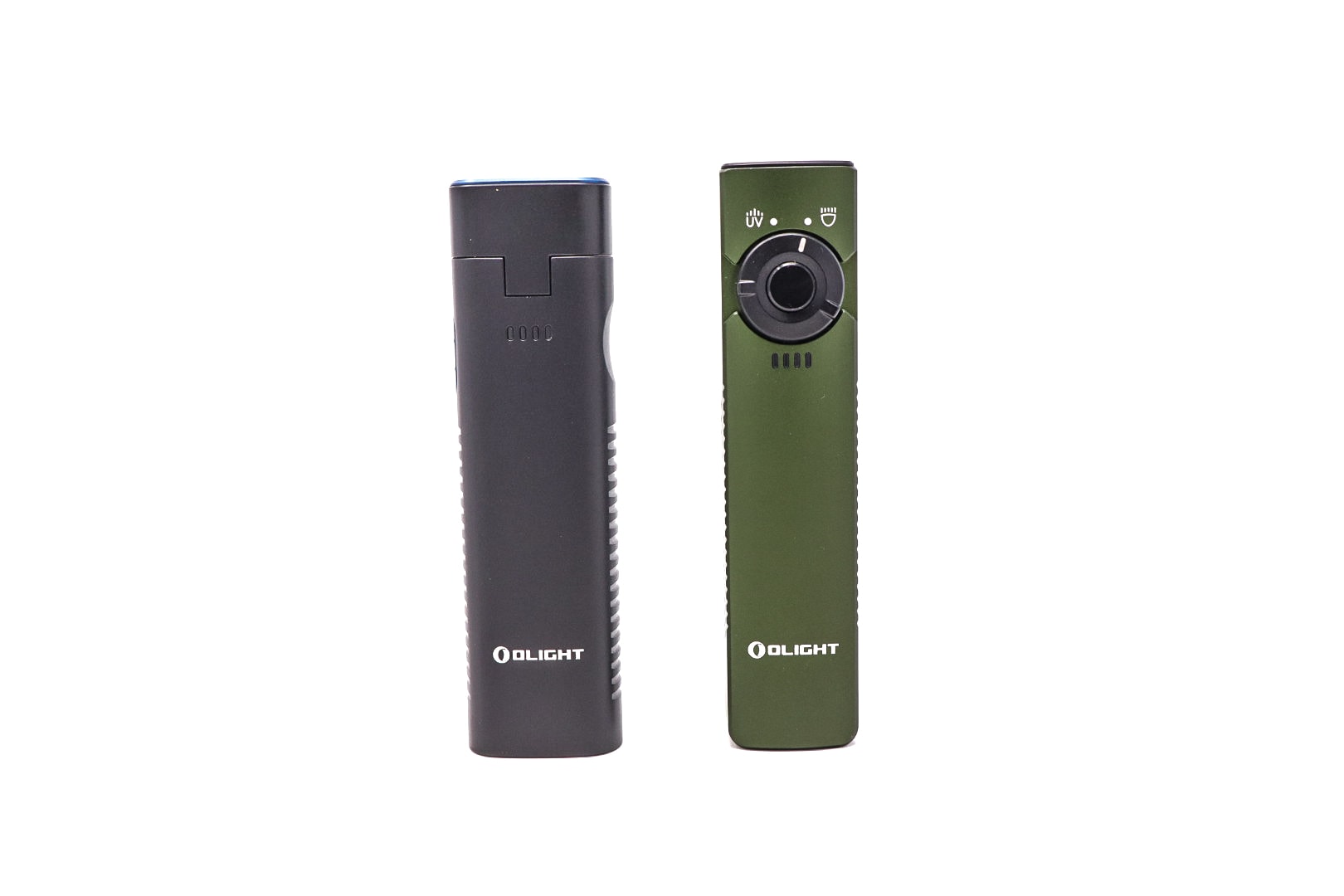
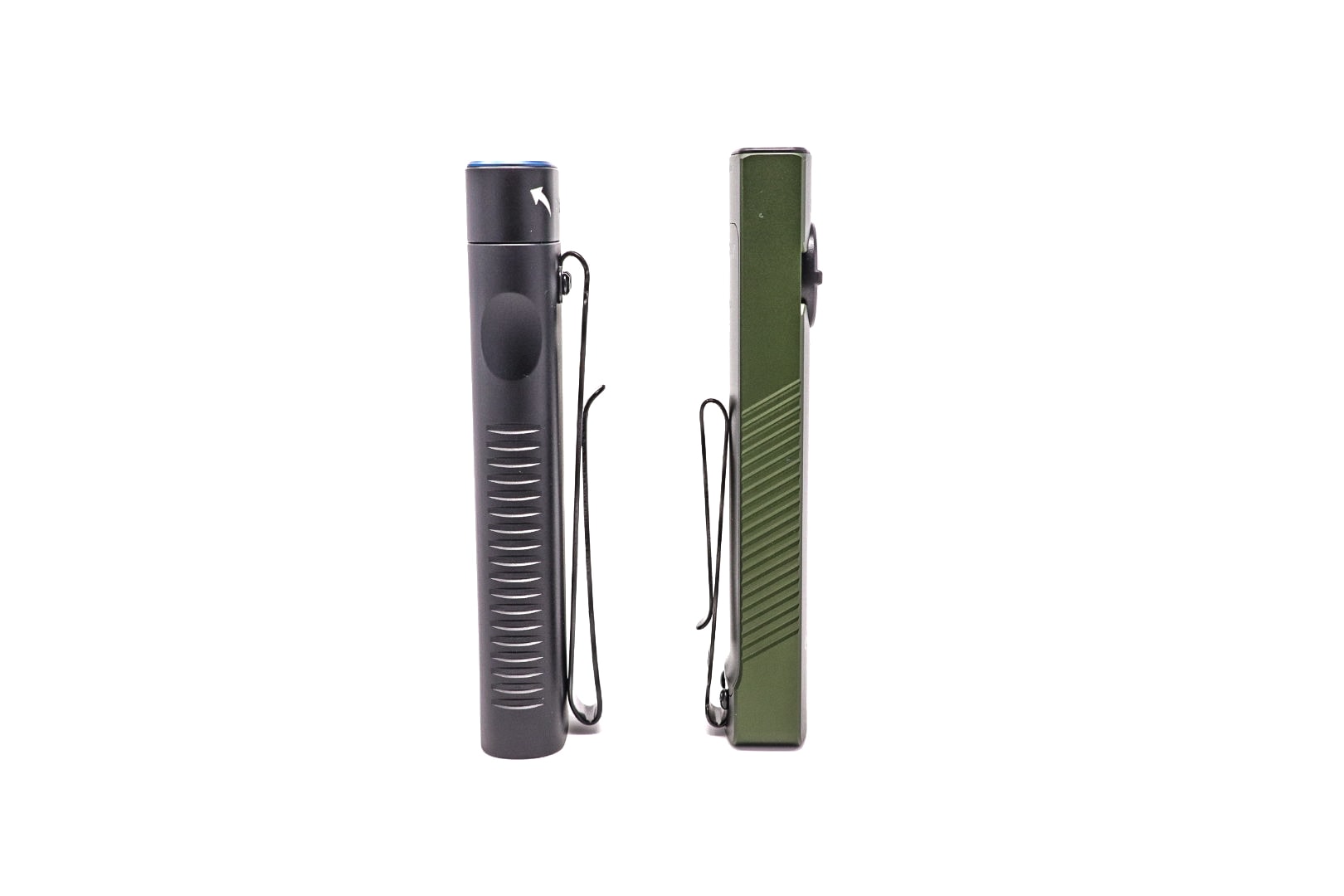
Olight Arkflex UI: User Interface and Driver
If you’ve used any Olight single e-switch light, this UI will be pretty familiar. Well, it’s pretty similar to most “standard” e-switch UIs, if there is such a thing.
Available modes:
- Moon, Low, Med, High, Turbo
Available blinky modes:
- Strobe
From OFF:
- Press and Hold 1 second: Moon
- Press and Hold 2+ seconds: Lockout
- Single click: turn On
- Double click: Turbo
- 3 clicks: Strobe
From ON:
- Press and Hold: change modes (Low > Med > High)
- 1 click: turn Off
- Double click (white light): Turbo
- 3 clicks: Strobe
Mode memory:
- There is mode memory for all brightness levels except for Turbo
- If you turn the light off in Turbo, it will turn back on in High
- Strobe mode cannot be memorized
Shortcuts:
- To Moon: press and hold 1 second from Off
- To Turbo: double click (from Off or On)
- To Strobe: triple click (from Off or On)
Low voltage warning/protection:
- There are four LED spots below the hinge that display the battery level:
- 4 green LEDs lit: >75%
- 3 green LEDs lit: 50-75%
- 2 green LEDs lit: 25-50%
- 1 green LED lit: 10-25%
- 1 red LED lit: <10%
- When turning the Arkflex on, the indicator lights do a nice sequential ramp up
- Whereas the Arkfeld’s indicator lights turn off after a few seconds, the Arkflex’s lights stay on while the flashlight is on (unless you’re in Moon mode)
- When turning the Arkflex off, the indicator LEDs remain lit for a couple of seconds, the ramp down in sequential order
Strobe/blinkies
- There is a strobe mode that can be activated with a triple click from Off or On
Lock-out mode:
- Electronic lockout mode is enabled by holding the button down for 2+ seconds while the light is off
PWM
- There is no PWM present
Additional/summary info on the UI:
- Most e-switch Olights that I’ve had (including the Arkfeld models) have a timer that you can enable. I’ve never really used it, but thought it was a nice inclusion. That feature seems to have been removed. It is not mentioned in the manual, and I am unable to activate it with the usual button sequence.
Olight Arkflex Charging and batteries
The Olight Arkflex uses a built-in battery. Olight says that the capacity of the battery is 3.89 Wh (1050 mAh / 3.7 V). Olight says the charge rate using the supplied MCC (magnetic charging cable) is 1 amp and a charge cycle should take around 1h 40min. My tests took just a bit longer than that, observing a charge rate of 0.88 amps (4.60W) and taking 2h 6min to complete the charge cycle.
| Charge type | Fits | No fit | Charge time |
|---|---|---|---|
| Olight MCC | Built-in | N/A | 2h 6min |
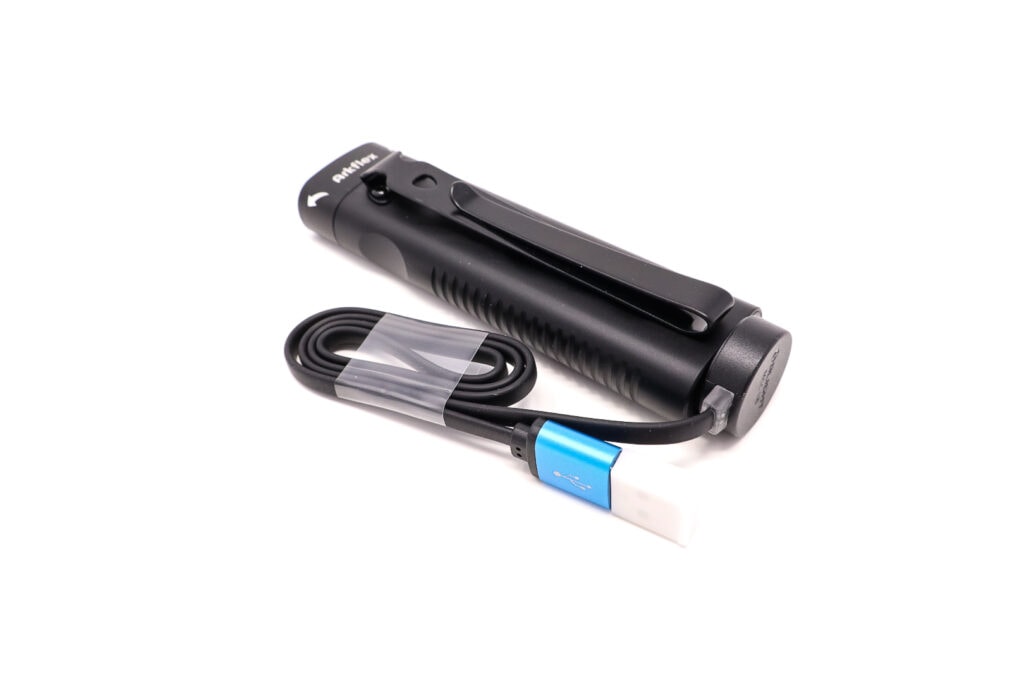
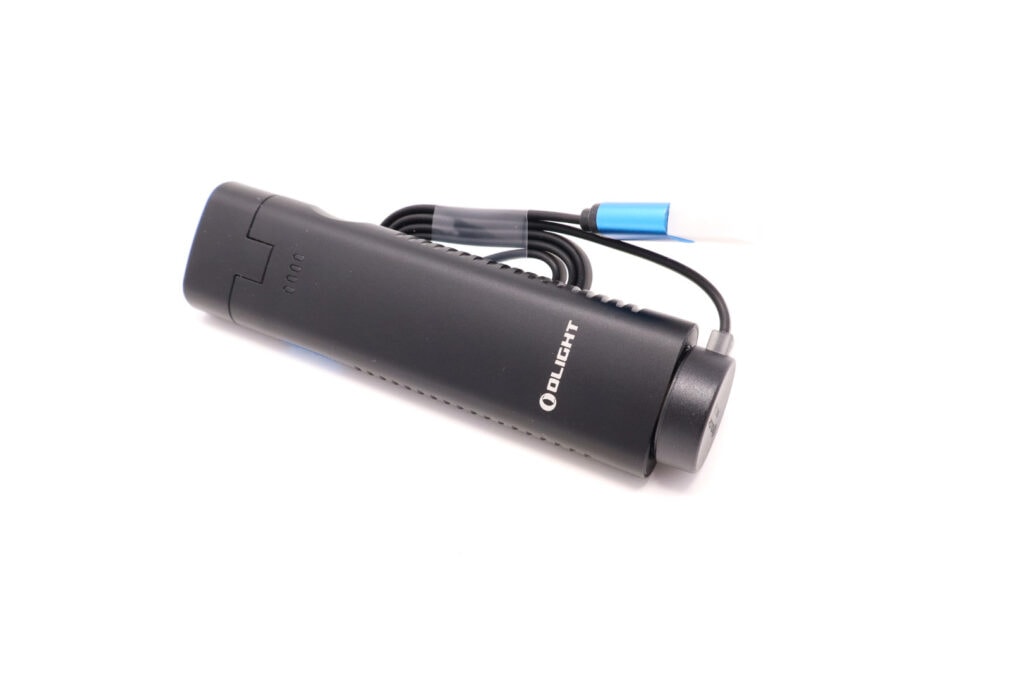
Performance test
Lumen measurements
How Lumens are Measured: Understanding ANSI FL1 Standards How Lumens are Measured: Understanding ANSI FL1 Standards: The ANSI FL1 standards specify that output in lumens should be measured 30 seconds after turning on, as this is the standardized time for measuring brightness according to the industry standard. This is why we focus on this part in our measurements. The ANSI FL1 standards require an ambient temperature of 22 ± 3°C. We record the ambient the ambient temperature to identify potential reasons for any observed discrepancies.Lux was measured by a UNI-T UT383 BT at 5 meters. Lumens were measured in a homemade lumen tube using a VEML7700 sensor, calibrated with a calibration light provided by 1Lumen. Due to the built-in nature of the battery, current tests were not possible.
| Mode | Specified | 0 sec. | 30 sec. | 10 min. |
|---|---|---|---|---|
| Moon | 1.5 lm | 1.4 lm | 1.4 lm | |
| Low | 15 lm | 13 lm | 13 lm | |
| Med | 100 lm | 85 lm | 85 lm | 85 lm |
| High | 400 lm | 386 lm | 385 lm | 384 lm |
| Turbo | 1000 lm | 931 lm | 938 lm | 383 lm |
Parasitic drain:
- N/A – couldn’t test due to built-in battery design
I’m happy to report that with the Arkflex, my measurements are really close to spec – good enough for me. I measured about 6% below spec for Turbo, which isn’t too bad of a deviation. Overall, no real surprises here. At 3 minutes, Turbo starts slowly ramping down to the High level.
Olight Arkflex Battery Life: Runtime graphs
How Runtimes are Measured: Understanding ANSI FL1 Standards About ANSI FL1 runtime standards: The runtime is measured until the light drops to 10% of its initial output (30 seconds after turning on). This does not mean that the flashlight is not usable anymore. The last column shows how long the light actually works till it shuts off. If there is a + symbol, it means that the test was stopped at that particular point, but the light was actually still running. This happens on certain occasions, with certain drivers, firmware, or batteries.| Mode | Specified | Measured runtime ANSI | Time till shut off |
|---|---|---|---|
| Moon | 10d | – | – |
| Low | 38h | – | – |
| Med | 6h 50min | 6h 28min | 6h 28min |
| High | 1h 40min | 1h 39min | 1h 48min |
| Turbo | 1h 34min | 1h 38min | 1h 47min |
Again, there are no real surprises here – and that’s a good thing! The runtimes are really close to spec.
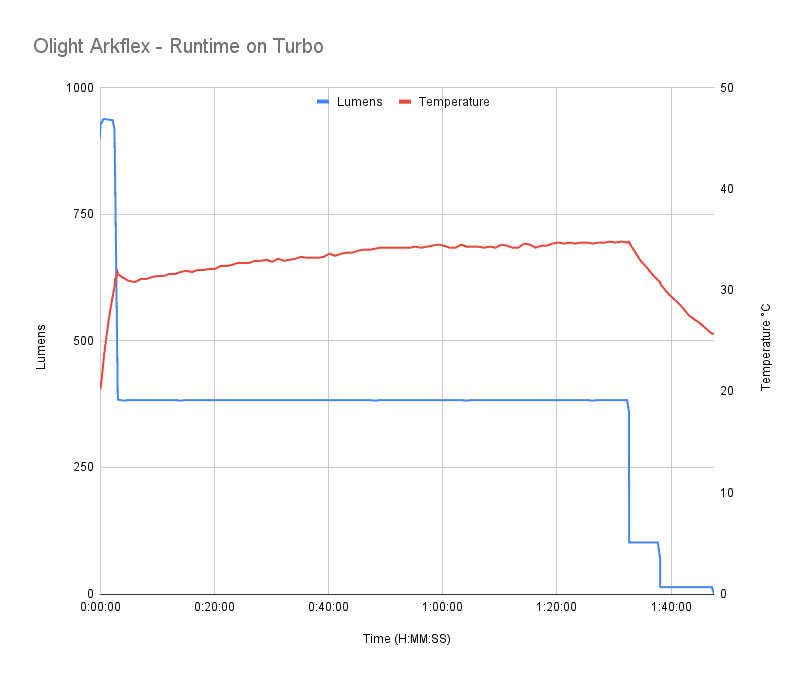
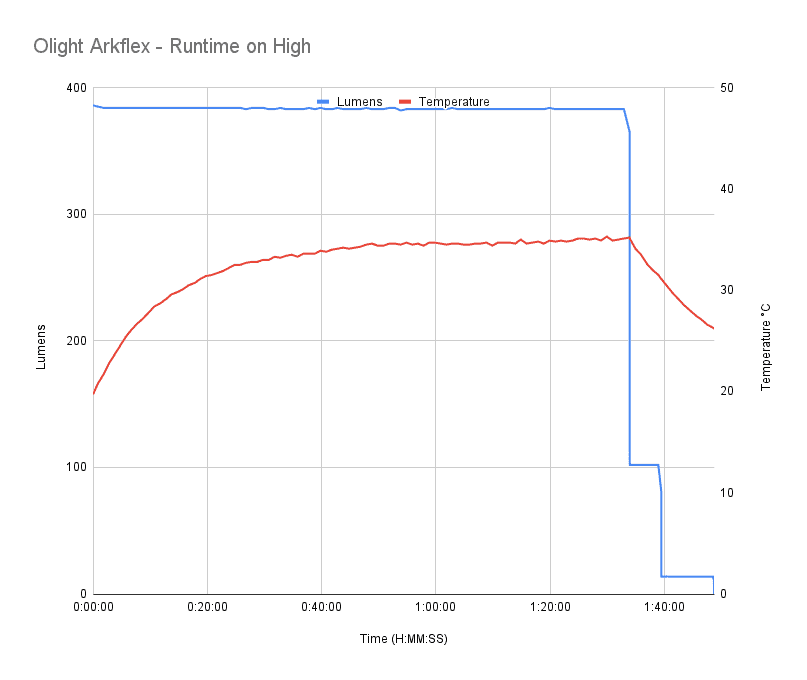
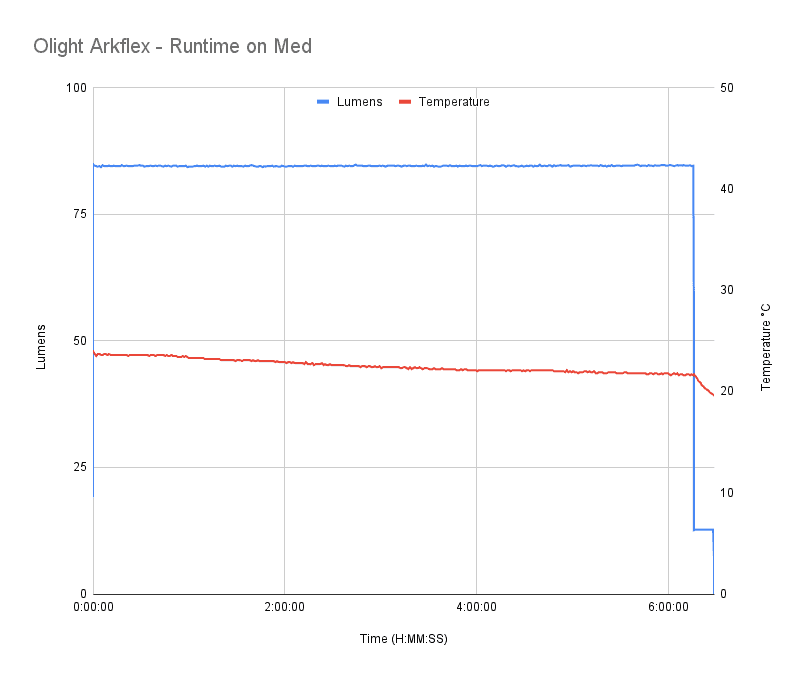

Peak beam intensity and beam distance measurements
About Peak beam intensity: Understanding ANSI FL1 Standards About peak beam intensity The calculated value of distance in meters at which the flashlight produces a light intensity of 0.25 lux. (0.25 lux is about the brightness of a full moon shining on an object). This means that the intensity has decreased so much, it becomes difficult to see darker objects, or objects that don’t reflect light. The columns ‘Meters’ and ‘Yards’ use rounded numbers.Intensity was measured at 5 meters after being turned on for 30 seconds. A UNI-T UT383 BT lux meter was used.
| Mode | Specified | Candela measured | Meters | Yards |
|---|---|---|---|---|
| Medium | – | 275 cd | 33 m | 36 yd |
| High | – | 900 cd | 60 m | 66 yd |
| Turbo | 1,900 cd | 2,200 cd | 94 m | 103 yd |
Olight only provided an intensity spec for Turbo mode. My measurement came in a little bit higher than that, but fairly close. Overall, the Arkflex is a pretty floody light, which is pretty good for a lot of EDC tasks.
Beamshots
Camera settings and distance:
Beam shots of the building are taken at 30 m (33 yd) using a Pixel 7 set to ISO 800 with 1/10 second exposure time
Beamshots of the following flashlights compared:
- Olight Arkflex
- Olight Arkfeld Pro
- Olight Arkfeld UV
- Olight Seeker 4 Mini
Please note that beamshots are mainly intended to showcase the beam pattern and beam quality, rather than overall performance. These images are typically taken directly after activation, and do not fully represent its overall performance. For accurate performance metrics, such as output, beam distance, and runtimes, you need to look at the performance section of this review.
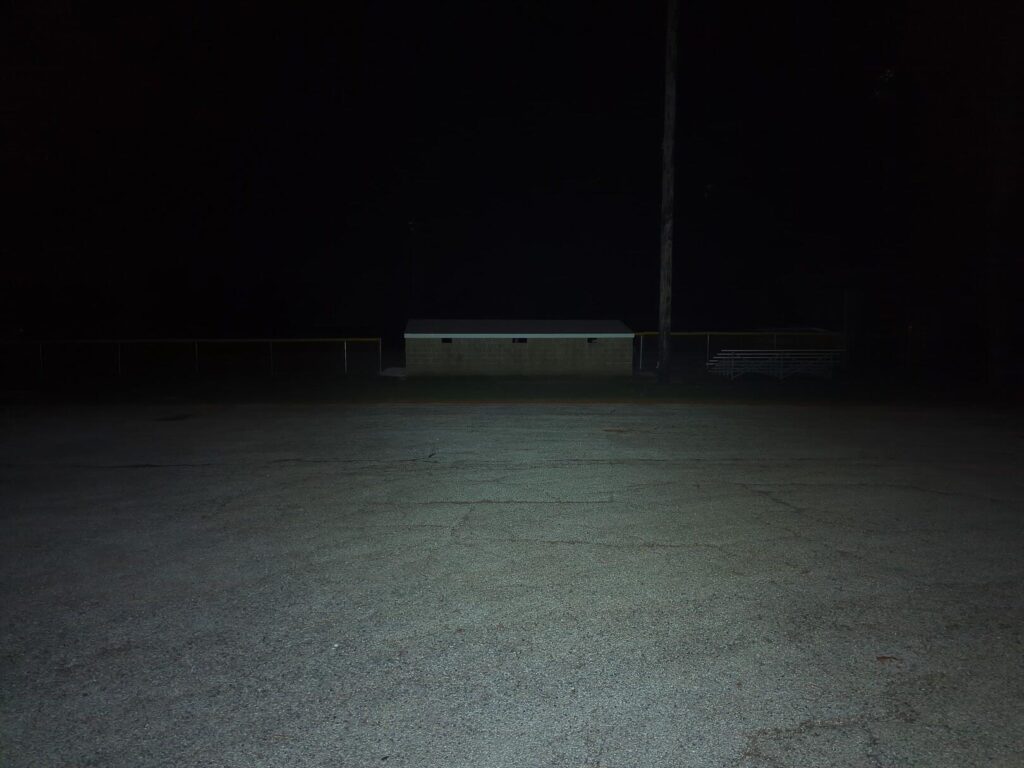
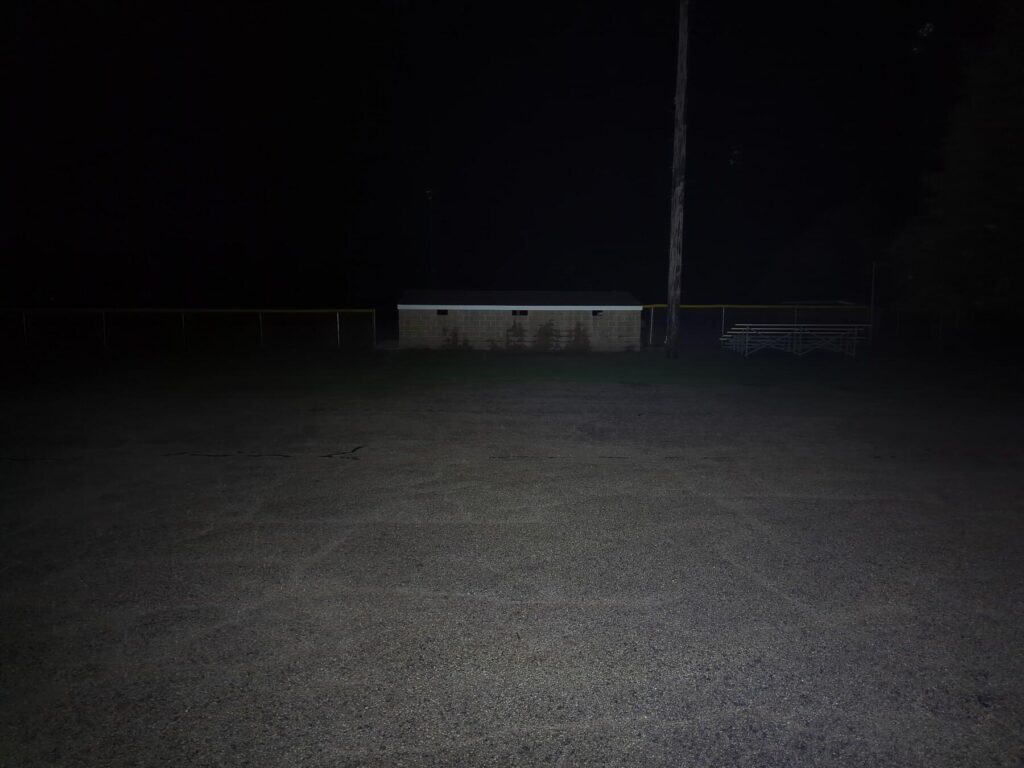
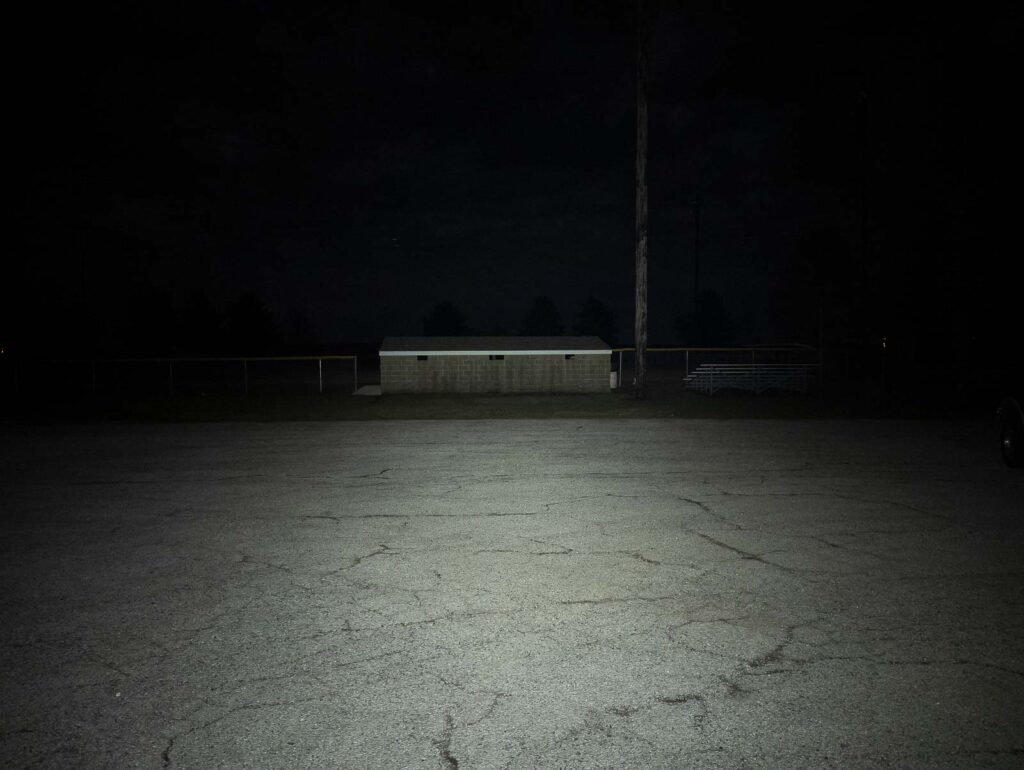

Disclaimer: This flashlight was sent to us for review at no cost by Olight. We have not been paid to review, nor have we been holding back on problems or defects.
Final Verdict
Pros
- Unique design
- Simple UI
- Good UI shortcuts
- Great regulation
- Easy battery level indication
- Magnetic charging
- Hinge seems robust
Cons
- No CCT choices
- It’s like an Arkfeld, but missing the UV/laser
Explanation on star ratings:
1: Avoid: a match would be a better choice – 2: Poor: significant defect or issues; almost unusable – 3: Average: some defects or issues; but still usable 4: Good: recommended (minor issues) – 5: Great: highly recommended

4.5 stars: ★★★★⋆
While our star rating provides a reliable indicator, we encourage you to read the full review to make an informed decision based on your own needs and preferences.
If you’ve liked the idea of the flat-design Olight Arkfeld, but never really had a use for UV or a laser in your day-to-day life, then this is your moment: Olight removed the auxiliary output and replaced it with a sweet hinge. So it’s no longer the pick for doing presentations or entertaining your cat (laser), nor is it great for currency inspection or finding stuff in a hotel room that you really didn’t want to know was there (UV).
However, that seemingly simple hinge provides 90° of movement that allows the brand new Olight Arkflex to double as a work light, forward-facing pocket light, or table-top illumination. Sure, I’m a bit picky when it comes to CCT and would have loved to see neutral and/or warm white options, but hopefully those will come in time. Regardless, the Olight Arkflex is truly a handy pocket companion.
Buy your Olight Arkflex with a discount
Use our exclusive 1lumen discount code to get an extra 10% off anything you order at Olightstore.com (USA). Coupon code: 1lumen
1lumen selects and reviews products personally. We may earn affiliate commissions through our links, which help support our testing.